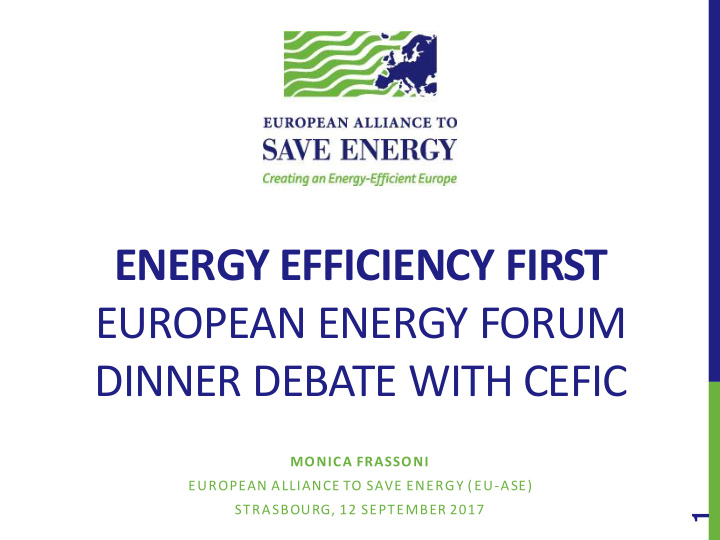



ENERGY EFFICIENCY FIRST EUROPEAN ENERGY FORUM DINNER DEBATE WITH CEFIC MONICA FRASSONI EUROPEAN ALLIANCE TO SAVE ENERGY (EU-ASE) STRASBOURG, 12 SEPTEMBER 2017 1
ABOUT EU-ASE • Established United Nations Climate Change Conference in December 2010 • Our objective To make the case for the urgent need for stronger action on energy efficiency in Europe • Who we are Some of Europe’s leading energy efficiency advocates: companies, politicians and campaigners. EU-ASE members have operations across the 28 Member States , employ over 340.000 people in Europe and have an aggregated annual turnover of € 115 billion . 2
ABOUT EU-ASE MEMBERS HONORARY MEMBERS 3
AN INSPIRING PRINCIPLE FOR POLICY-MAKERS: EFFICIENCY FIRST! Highly energy performing individual buildings EFFICIENCY FIRST Highly efficient energy system Empowered and engaged end-users 4
THE MULTIPLE POSITIVE IMPACTS OF AMBITIOUS EE TARGET AND POLICIES ARE WELL RECOGNIZED… The latest Cambridge Econometrics study “The macro-level and sectoral impacts of energy efficiency policies” (July 2017): multiple collective benefits increase significantly with higher policy ambition. With a 2030 EU energy efficiency target at 40% the following impacts are calculated: ➢ up to 4% increase in the EU's GDP ➢ up to 3 million new jobs ➢ savings of up to € 77bn in annual healthcare costs ➢ up to 8 million households (about 20 million people) lifted out of energy poverty ➢ up to 47% reduction in GHG emissions (the pre-Paris EU's current goal is 40% GHG cuts) 5
…AND CAN BE ACHIEVED IN DIFFERENT SECTORS… Relative savings potentials per year (2015-2030) in final energy 6 Source: Ecofyscalculations
…EE IN INDUSTRY HAS SOME POTENTIAL… Energy Efficiency Potential in 8 energy intensive industrial sectors Description 2030 2050 The Technical Potential illustrates the Technical Potential maximum energy saving potential 20% 23% which is technically feasible The Economic Potential illustrates Economic Potential what industry might consider to be 4-5%* 8-10%* economically feasible * Variationdepending onhigh/low hurdle rate Source: ICF’ Study on Energy Efficiency and Energy Saving Potential in Industry and on Possible policy mechanism. Contract No . ENER/C3/2012-439/S12.666002. Year 2015 7
…BUT BUILDING RENOVATION HAS THE MOST COST-EFFECTIVE POTENTIAL • Existing buildings representone of the largest opportunities for energy savings • Buildings consume40% of final energy in Europe • 75% of them built with low (or no) energy efficiency requirements • 75-85% of themwill still be in use in 2050 • Increasing the rate, depth, quality, and effectiveness of building renovation is one of the biggest challenges for thecoming decades • Building renovation cycles happen only every +30/50 years • Low rate of renovation : 0.4 – 1.2% per year • This indicates that the former art. 4 EED by itself has not sufficiently driven renovation activities since 2012 and that additional measures should be taken in the framework of the EED/EPBD revisions to speed up this process . • Beyond energy and cost savings the co-benefits of building energy renovation are: economic growth and creation of local jobs ; energy security (reduction of gas imports); better health (physical / mental health / improved work productivity and learning ability), air pollution reduction (like for example in Poland); and not least resilience (more efficient stock reduces the peak of energy demand … hence facilitates integration of renewables at largescale). 8
HENCE, MEETING THE 2030 EE TARGET REQUIRES A CLEAR FOCUS ON BUILDING RENOVATION… EU-ASE calls on EU institutions to seize the opportunity provided with this revision to put existing buildings at the centre of the EU’s energy efficiency strategy and ensure that the new policy framework* for energy renovation is aligned with the EU Energy Efficiency ambition for 2030. With a solid Clean Energy Package, it is possible to accelerate the rate of energy renovation (3% is needed to fulfil our 2050 ambition) as well as their depth and quality. * Incl. renovation strategies, ambition for the building stock, 2030 renovation milestones, art.7 EED, financing, skills, industry investment, etc … 9
…AND A SOLID LINK BETWEEN THE EE 2030 TARGET AND NATIONAL RENOVATION STRATEGIES Member States shall: ➢ Set out a roadmap with clear milestones (in 2030 and 2040) and actions to deliver on the long-term 2050 goal to ensure a highly energy efficient and decarbonized building stock ➢ Identify measurable progress indicators ➢ specify how their milestones contribute to achieving the EU energy efficiency targetin 2030 10
THANK YOU! European Alliance to Save Energy info@euase.eu www.euase.eu 11
Recommend
More recommend